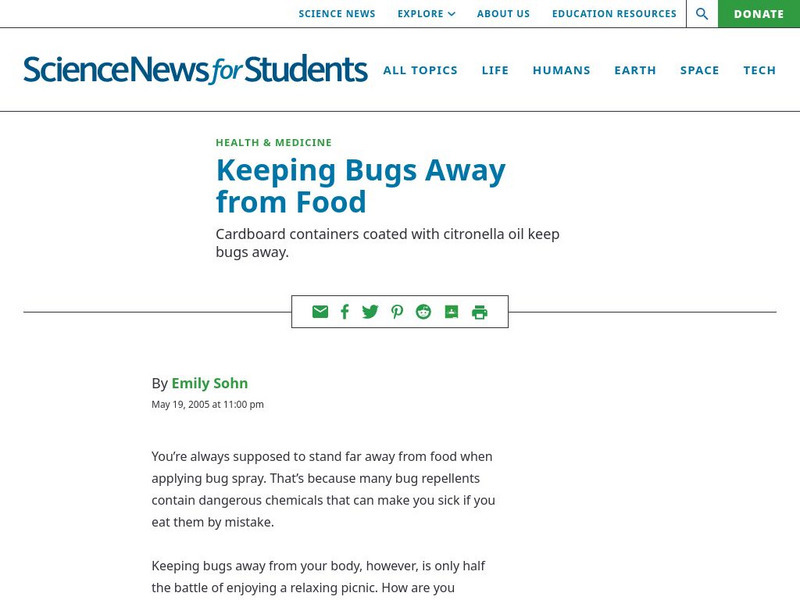Ed Koday
Ivy Hall: Mosquito
Have an itch to learn all about mosquitos? Stop here for many facts and images of the common warm weather insect.
Ed Koday
Ivy Hall: Hercules Beetle
Find out some facts about the Hercules beetle and take a look at some pictures of them.
Ed Koday
Web Archive: Tiger Beetle
The tiger beetles are among the most obvious of beetles, yet can be difficult to collect. They are very active and alert, running swiftly over the ground and, unlike almost all other beetles, taking flight without a split second's...
Ed Koday
Web Archive: Box Elder Bug
This bug is about 1/2 inch long and 1/3 as wide. It is black with three red lines on the thorax, a red line along each side, and a red line on each wing. The wings lie flat on the back when at rest. The young nymphs are red and gray. The...
Ed Koday
Web Archive: Ambush Bug
Ambush bugs are predators which normally lie in wait for prey. They have front legs fitted for grasping, much like that of a praying mantis. They commonly sit on a flower waiting for insects attracted to flowers. Goldenrod is a favorite...
Ed Koday
Web Archive: Gypsy Moths
Lean more information about Gypsy Moths by reading this reference material.
Ed Koday
Web Archive: Spittle Bug
There are 23,000 species of spittle bugs, but you may not have ever seen one because of the unusual way that they protect themselves. They actually produce a liquid that they whip up into a mass of bubbles, and then they hide in it! This...
Ed Koday
Web Archive: Milkweed Bugs
Adults are 9/16 to 10/16 inch long, black, and colorfully marked with reddish-orange on the head, sides of the pronotum (part of the thorax), and the wing covers. They have a Y-shaped head marking and two wide crossing orange bands...
Ed Koday
Web Archive: Beetles
Beetles might be the most successful creatures on earth! Their incredible ability to adapt to any environment makes sure that they will exist, probably long after humans have disappeared from earth. One of the most important features of...
Society for Science and the Public
Science News for Students: Keeping Bugs Away From Food
Discover how scientists in New Zealand kept bugs out of food boxes. How did they do this? They coated the cardboard boxes with citronella oil. Bugs hate the stink of citronella so they stay away from the food!
University of Florida
Baldwin Library: Wings and Stings by a.l.o.e.
This is an online photocopy of the original text of the children's book Wings and Stings, or, Lessons from Insect Life by A.L.O.E. [1870], a children's novel showing what can be learned from watching insects.
TED Talks
Ted: Ted Ed: Why Are There So Many Insects?
Murry Gans details the reasons behind insect abundance across the globe. [4:44]
TED Talks
Ted: Ted Ed: Should We Eat Bugs?
What's tasty, abundant and high in protein? Bugs! Although less common outside the tropics, entomophagy, the practice of eating bugs, was once extremely widespread throughout cultures. Insects hold promise for food security and the...
University of Florida
Baldwin Library: Sketches of British Insects by William Houghton
This is an online photocopy of the original text of the children's book Sketches of British Insects: A Handbook for Beginners in the Study of Entomology by William Houghton (1888), an illustrated introductory textbook on the subject of...
PBS
Pbs Kids: Dinosaur Train: River Run
Don and Buddy are going rafting down the river looking for bugs for Don's collection. Whoever collects the most bugs wins!
Earth Life
Earth Life/life Cycles of Insects
A vey in-depth look at the life cycle of insects. You will learn about the metamorphisis and reproduction of insects.
PBS
Nova Online: Curse of t.rex
NOVA site provides cool science facts on dinosaurs as well as additional links and resources.
Cornell Lab of Ornithology
Habitat Network: Support Pollinators: A Goal for Your Site?
Find out the three easy steps citizens can take to support pollinators including providing shelter and nesting materials, food, and avoiding using chemicals like pesticides and fertilizers.
Other
Uk Safari: Creepy Crawlies
Click on a picture of an arthropod, such as an earthworm, spider, or slug, and a picture, description, and other facts will appear along with the photo of the insect.
Other
Alphabet soup.com: Insects and Spiders
An extensive list of activities, songs, poems, and fingerplays are listed by alphabet-soup.com. Additional recipes, art projects, and literature connections are also included.
Other
Bugbios: Entophiles
Students can see pictures and descriptions of 14 different orders of insects.












